|
< Earlier Kibitzing · PAGE 2 OF 2 ·
Later Kibitzing> |
| Sep-13-13 | | newzild: I missed the brilliant shot at the end. It would be hard to spot over the board, I think. |
|
| Sep-13-13 | | morfishine: I missed this conceptually, thematically and actually ***** |
|
| Sep-13-13 | | Morttuus: Another Traxler counterattack success. :-)
Abdel Irada: Yes, you're right with that dr. Tarrasch quotation. :-) On the other hand, Bobby Fischer considered 4. Ng5 as a good move. Dr. Tarrasch may have been too rigid, but I think 4. Ng5 is a direct attacking move which is not suitable against each player. Maybe it is more psychological than logical...:-) |
|
Sep-13-13
 | | FSR: I thought of that line, but I was looking for something faster. |
|
Sep-13-13
 | | FSR: Interesting. According to ChessBase 12, all the computers like 5.Nxf7 Bxf2+ 6.Kf1 for White. Assessments: 1.77 depth=37 Stockfish 3 SE
1.28 depth=30 Houdini 3 x64
0.73 depth=27 Houdini 2.0 x64 |
|
| Sep-13-13 | | Abdel Irada: <FSR: Interesting. According to ChessBase 12, all the computers like 5.Nxf7 Bxf2+ 6.Kf1 for White. Assessments: 1.77 depth=37 Stockfish 3 SE
1.28 depth=30 Houdini 3 x64
0.73 depth=27 Houdini 2.0 x64>
That's part of what I was saying about a computer defending the positions that arise from the 4. Ng5 lines. The software can "see" all the attacking resources and find ways to counter them; a human player is more likely to perform an impression of a deer caught in the headlights. This is probably why computers rate White's chances well, but the overwhelming majority of victories in the database have gone to Black. ∞ |
|
| Sep-13-13 | | hedgeh0g: I missed 14...Ne2! - a very cute move.
Maybe the best way to prepare for/against the Traxler is to play the other side against a computer and see how it responds to what you consider to be the most threatening lines. I never play the Italian Game as White, but if I did, I wouldn't go near 4.Ng5. |
|
| Sep-13-13 | | Abdel Irada: <Maybe the best way to prepare for/against the Traxler is to play the other side against a computer and see how it responds to what you consider to be the most threatening lines.> You could spend a *long* time doing that. ;-)
∞ |
|
Sep-13-13
 | | FSR: I thought Anand was supposed to have pretty much refuted the Traxler in Anand vs Beliavsky, 1991 - except that he somehow managed to lose. Incidentally, Big Al isn't shy about playing the Traxler against strong opposition. See also his draw in Karpov vs Beliavsky, 1983. |
|
| Sep-13-13 | | patzer2: <chessthomas: hmm, what about
11. - Df4+ 12. Kg2 !?> After 11. Qf4+ 12. Kg2, I like <Gofer> and <Abdel Irada>'s 12. Ncd4!  (position below) (position below)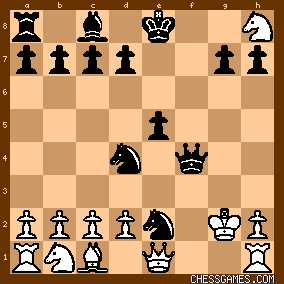
click for larger viewHere (i.e. after 11...Qf4+ 12. Kg2 Ncd4!  ) Black threatens mate on the move with 13...Qf3# (e.g. 13.Nc3 Qf3#; 13...c3 Qf3#). ) Black threatens mate on the move with 13...Qf3# (e.g. 13.Nc3 Qf3#; 13...c3 Qf3#). Fritz 12 indicates 13. Qf1 (position below) maximizes resistance. 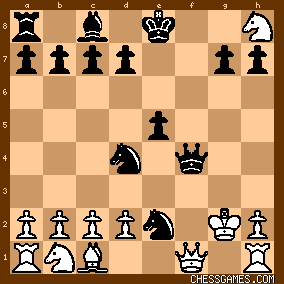
click for larger viewFrom this position (above) Black has an amusing mate (mate-in-eleven or less according to Fritz) with 13... Qg4+ 14. Kf2 14...Ng3! 15. hxg3 Qf3+ 16. Kg1 Qxg3+ 17. Qg2 Nf3+ 18. Kf1 Qe1# (position below) 
click for larger viewP.S.: My complete analysis with Fritz 12 in the 11...Qf4+ 12. Kg2 variations: <11...Qf4+> 12. Kg2 Ncd4
13. Qf1
(13. c3 Qf3#; 13. Qf2 Qe4+ 14. Kh3 d5+ 15. Qf5 Bxf5#; 13. h4 Qf3+ 14.
Kh2 d5 15. Nc3 Qh3#; 13. Rf1 Qe4+ 14. Kh3 d6+ 15. Rf5 Bxf5#; 13. h3 Qe4+ 14. Kh2 Nf3+ 15. Kg2 Nh4+ 16. Kf2 Qf3#; 13. Kh3 d6+ 14. Kg2 Qf3#; 13. Nc3 Qf3#) 13... Qg4+ 14. Kf2 Ng3 15. hxg3 Qf3+ 16. Kg1 Qxg3+ 17. Qg2 Nf3+ 18. Kf1 Qe1#. |
|
| Sep-13-13 | | Abdel Irada: <FSR: I thought Anand was supposed to have pretty much refuted the Traxler> I know you meant this at least quasi-facetiously, but refuting the Traxler is no minor matter. It incorporates a *lot* of variations, doubtless including many that we haven't yet discovered. ∞ |
|
| Sep-13-13 | | pericles of athens: White's 10. Nxh8 seems far too greedy in light of his exposed King. |
|
| Sep-13-13 | | NimzoCharlie: It stops mate in 3 by 14. ...bf5+ 15. Kc3 Nb5+ 16. Kb3 Qc4# |
|
| Sep-13-13 | | kevin86: Both sides extend an attack...But white's only used one piece,while black's involved several. Guess who won? Mate will come soonest. |
|
| Sep-13-13 | | takchess: It's great fun to play the Traxler and I play 1.e4 e5 so I can occasionally play it. I think this is the only thing which is stopping me from playing the Sicilian as black. For a walkthrough of some of the lines, take a look here
Game Collection: Wandering Tour through the Traxler Counterattack Jim |
|
| Sep-13-13 | | agb2002: Black has two pawns for a rook.
White threatens 12.Qxe2.
Black has a number of options: 11... Qf4+, 11... Qh4+, 11... d5, 11... d6, etc. In the case of 11... Qf4+:
A) 12.Kxe2 Nd4+ 13.Kd3 (13.Kd1 Qf3+ 14.Qe2 Qxe2#) 13... d5 A.1) 14.Rf1 Bf5+ 15.Kc3 Nb5+ 16.Qc4#.
A.2) 14.c4 Bf5+ 15.Kc3 Nb5+ 16.Kb4 (16.cxb5 Qc4#; 16.Kb3 Qxc4#) 16... Qxc4+ 17.Ka5 b6+ 18.Ka6 Bc8# or 18... Nd6#. A.3) 14.Nc3 Bf5+ 15.Ne4 Bxe4+ 16.Kc3 Bxh1 looks winning. A.4) 14.b3 Nb5 (14... Bf5+ 15.Kc3 Nxc2 16.Qg1) 15.Nc3 (15.Ke2 Bg4+ 16.Kd3 Qd4#; 15.c4 Bf5+ 16.Qe4 Qxe4#) 15... Bf5+ 16.Ne4 Bxe4+ 17.Ke2 Qf3#. A.5) 14.b4 is similar to A.4.
A.6) 14.a4 is similar to A.2.
A.7) 14.Kc3 Nb5+ 15.Kd3 (15.Kb3 Qc4#) 15... Bf5+ 16.Ke2 Bg4+ 17.Kd3 Qd4#. A.8) 14.Qf1 Qe4+ 15.Kc3 Ne2+ wins.
B) 12.Kg2 Qe4+ (12... Qg4+ probably also works)
B.1) 13.Kh3 d5#.
B.2) 13.Kf1 Qxh1+ 14.Kf2 (14.Kxe2 Nd4+ 15.Kf2 (15.Kd1 Qf3+ 16.Qe2 Qxe2#) 15... Qf3+ 16.Kg1 Ne2+ wins) 14... Qxh2+ keeps the attack with three extra pawns or 14... Qxe1+ 15.Kxe1 Nxc1 wins a piece. B.3) 13.Kf2 Ncd4 14.Qf1 (threatens Qf7+ Kd8 Qf8# after a king move) 14... Nf4 with the threat Qf3+ looks winning (15.Qd1 Qg2+ 16.Ke3 Nf5#). |
|
| Sep-13-13 | | BOSTER: I don't know why we try to show that players are too stupid.
After 5...Bxf2+ white is not obliged to <beat> on "f2" he could simple retreat to "f1", where white king is safe.
After 6. Kf1 Qe7 (forced) 7.Nxh8.
White is better.
Even after 6.Kxf2 Nxe4+ the king could go to 7.Ke3 and black queen had to move f6 or h4.
if 7...Qf6 8.Rf1
if 7...Qh4 8.Qf3 and black is lost. |
|
| Sep-13-13 | | takchess: <Boster> 6 Kf1 is the best move at that point but still plenty of tricky moves as evidenced here; Game Collection: Wandering Tour through the Traxler Counterattack Let's just say it's a romantic opening.... |
|
| Sep-13-13 | | Abdel Irada: <BOSTER>: Your analysis is awfully superficial. After 5. Nxf7, there *is* no safety for White's king. It is relatively safer to play 6. Kf1 than to accept the bishop (and allows time to carry out the fork), but only at the cost of allowing different kinds of resources for Black. For example, in the variation you cite, 6. Kf1, Qe7 7. Nxh8, d5 8. exd5 (8. Bxd5?, Bg4  ), Bg4 9. Be2, Bxe2† 10. Qxe2, Nd4 11. Qxf2, O-O-O and Black has a strong attack with threats of 12. ...Rf8. Note also that 8. ...Nd4 may be stronger than 8. ...Bg4. ), Bg4 9. Be2, Bxe2† 10. Qxe2, Nd4 11. Qxf2, O-O-O and Black has a strong attack with threats of 12. ...Rf8. Note also that 8. ...Nd4 may be stronger than 8. ...Bg4. ∞ |
|
Sep-13-13
 | | Jimfromprovidence: The reason 13...d6? is no good is now white can hold with 14 Qf1!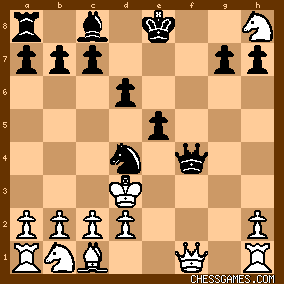
click for larger view
As stated by others black can't now check on e4. 14...Bf5+ does not help as white's king can safely go to c3. 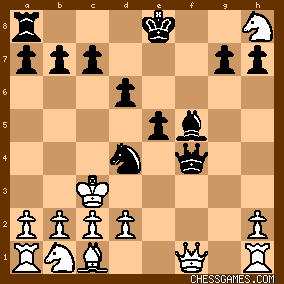
click for larger viewBlack can try 15...Ne2+, but after 16 Qxe2 Qd4+ 17 Kb3 it looks like a perpetual. 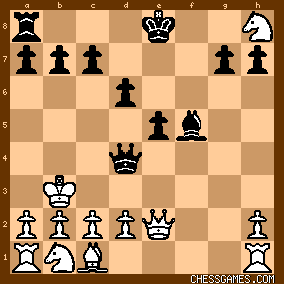
click for larger view |
|
| Sep-13-13 | | Dezaxa: 4. Ng5 may be a "duffer's move", but some pretty good duffers have played it... Fischer, Karpov, Korchnoi, Kasparov, Anand, to name a few. In fact, in Fischer's "My 60 Memorable Games" he says that this is the only way for White to try for an advantage. |
|
Sep-13-13
 | | Penguincw: I got up to 13.Kd3. |
|
Sep-13-13
 | | FSR: The Traxler/Wilkes-Barre is an amazing line. There are not a lot of games, but Mega Database 2013 shows no main line in which White gets a plus score: White scores only 38% in the engine-beloved 5.Nxf7 Bxf2+ 6.Kf1 Qe7 7.Nxh8 d5 8.exd5 Nd4 variation (52 games). He gets 50% with the line seen in the present game, 5.Nxf7 Bxf2+ 6.Kxf2 Nxe4+ 7.Kg1 Qh4 8.g3 Nxg3 (29 games). White also scores 50% in the theoretical best line 5.Bxf7+ Ke7 6.Bd5 Rf8 7.0-0 d6 8.h3 (25 games). (Efimov got the bright idea of playing 7.Rf1? - did he touch the rook first, instead of the king? - but Shirov "effed" him up in I Efimov vs Shirov, 1991.) The other bishop retreat only scores 41% in 37 games following 5.Bxf7+ Ke7 6.Bb3 Rf8. Finally, White can wimp out with 5.0-0 0-0 (46% in 28 games). There are other variations, of course, but they haven't been played often enough for ChessBase to consider them main lines. For example, there's the <total> wimp-out variation 5.d4 d5! 6.dxc5! dxc4 7.Qxd8+ Nxd8 (+1 =1 -1), when best is 8.Nc3! with complete equality. 5.Nxf7 Bxf2+ 6.Kxf2 Nxe4+ 7.Ke3, which should perhaps be called the Missouri Variation (after the "Show Me State"), scores abysmally - 1 win, 3 draws, and 13 losses for White. But maybe it's playable - see G Johnstone vs B Finegold, 1992 (draw by perpetual). |
|
Jun-13-16
 | | perfidious: <Abdel Irada...."Man who lead with jaw, soon take canvas nap."> Most amusing, and a fate often meted out when avarice overtakes prudence as White plays 5.Nxf7. <FSR: Interesting. According to ChessBase 12, all the computers like 5.Nxf7 Bxf2+ 6.Kf1 for White....> How do the silicon monstahs view the theoretically favoured 5.Bxf7+ Ke7 6.Bd5? |
|
Jun-14-16
 | | FSR: <perfidious> After 6.Bd5, the monstahs reckon that White is up a pawn for not much, giving an assessment of between +.75 and +.86. |
|
 |
|
< Earlier Kibitzing · PAGE 2 OF 2 ·
Later Kibitzing> |





